牛津译林版(2019)选择性必修 第一册 Unit 3 The art of painting Integrated skills 课件(共22张PPT,内嵌视频)
文档属性
| 名称 | 牛津译林版(2019)选择性必修 第一册 Unit 3 The art of painting Integrated skills 课件(共22张PPT,内嵌视频) |
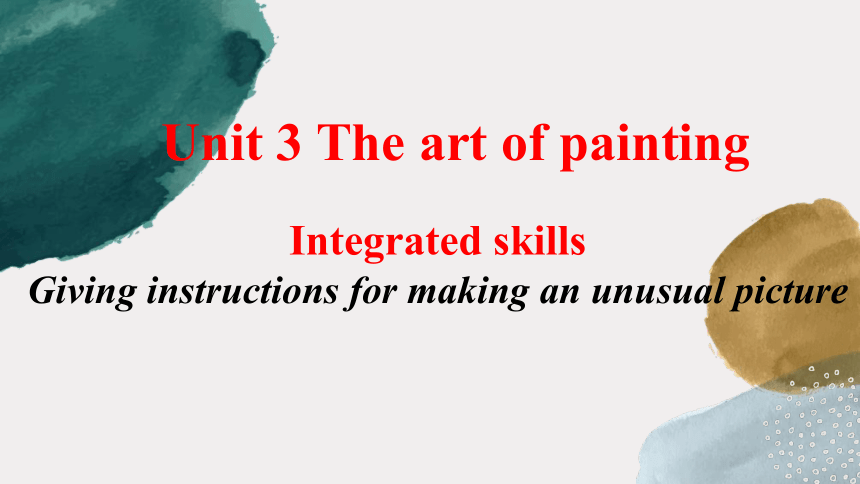
|
|
| 格式 | pptx | ||
| 文件大小 | 92.9MB | ||
| 资源类型 | 教案 | ||
| 版本资源 | 牛津译林版(2019) | ||
| 科目 | 英语 | ||
| 更新时间 | 2024-09-19 17:24:05 | ||
图片预览

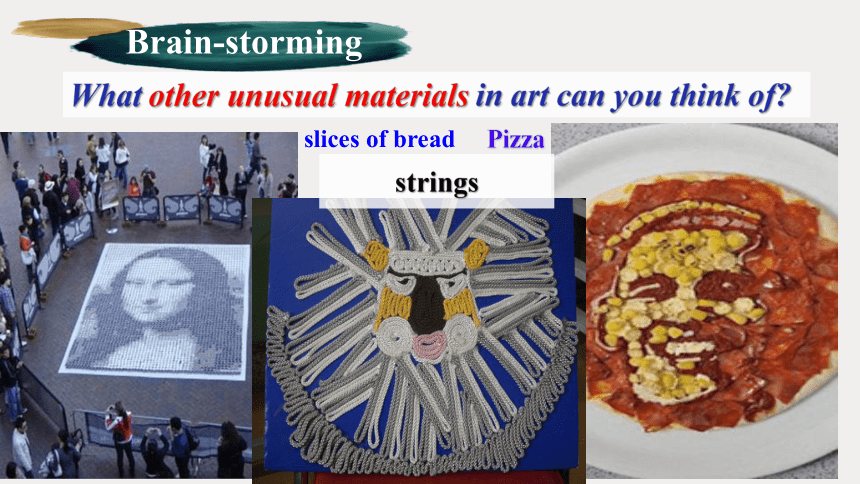
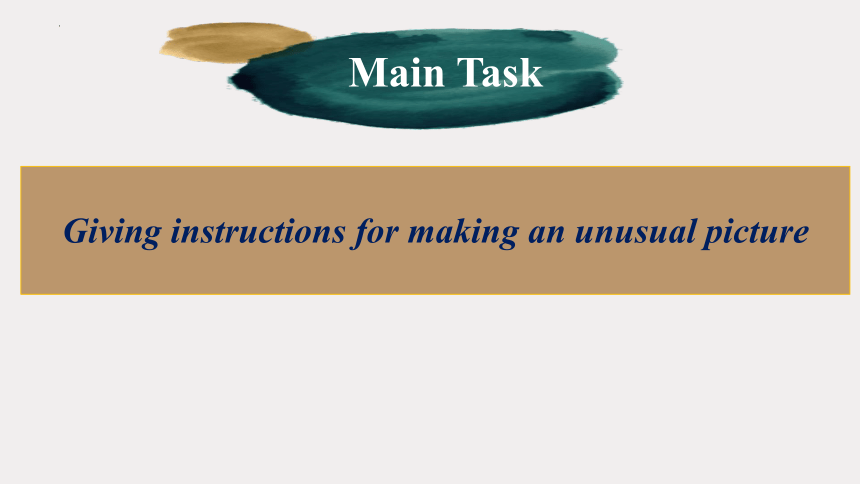
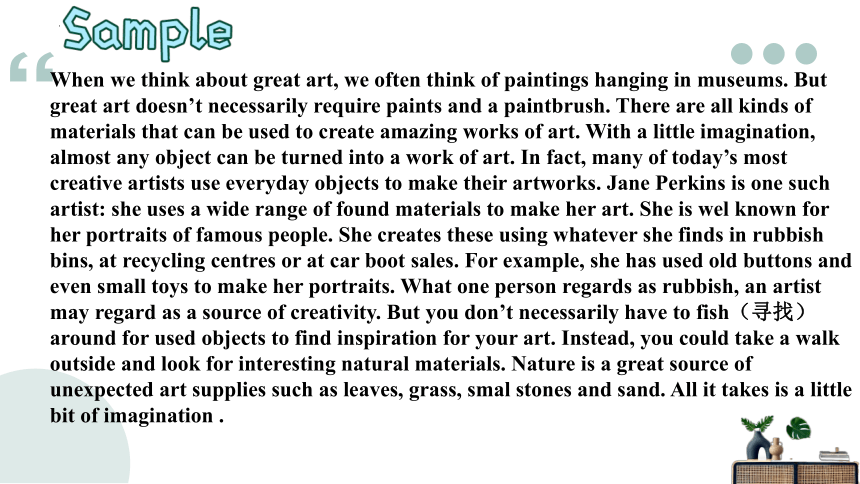
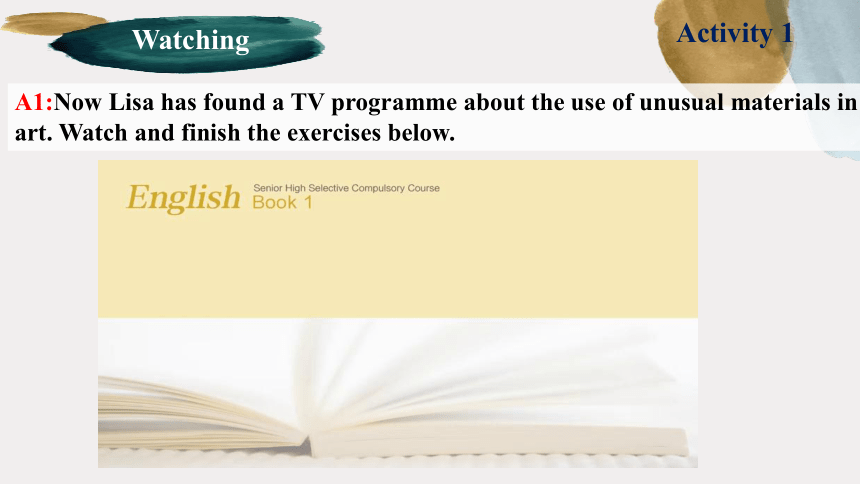
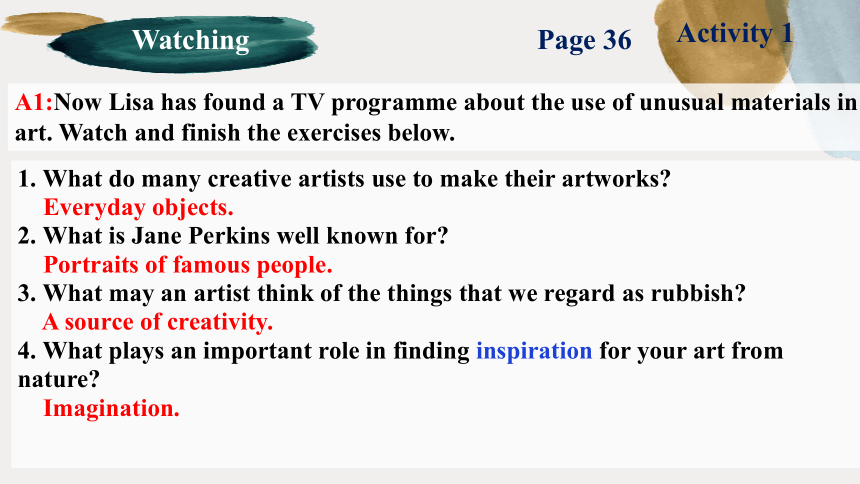
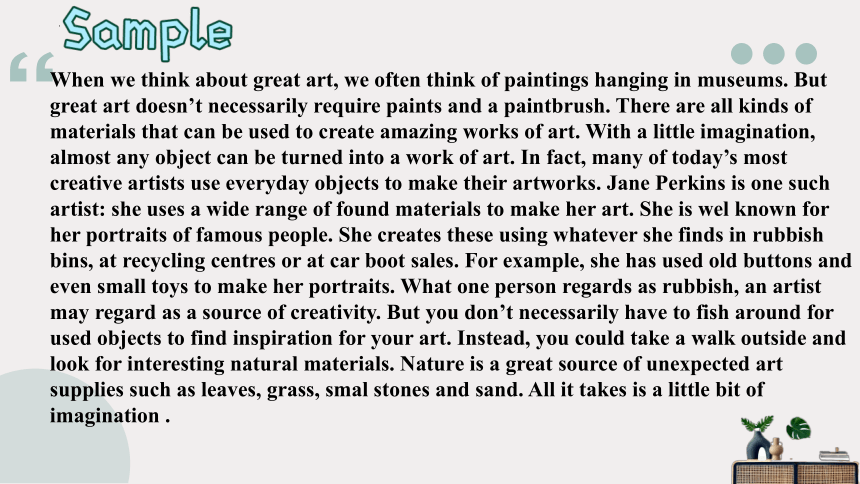
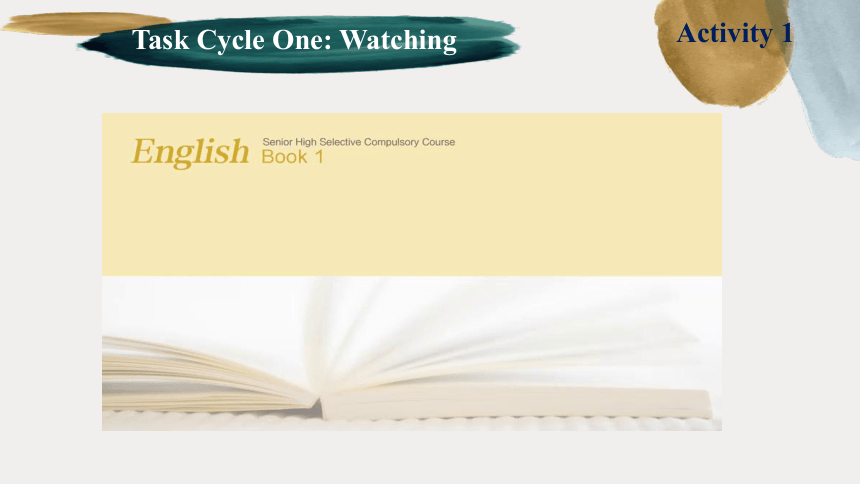
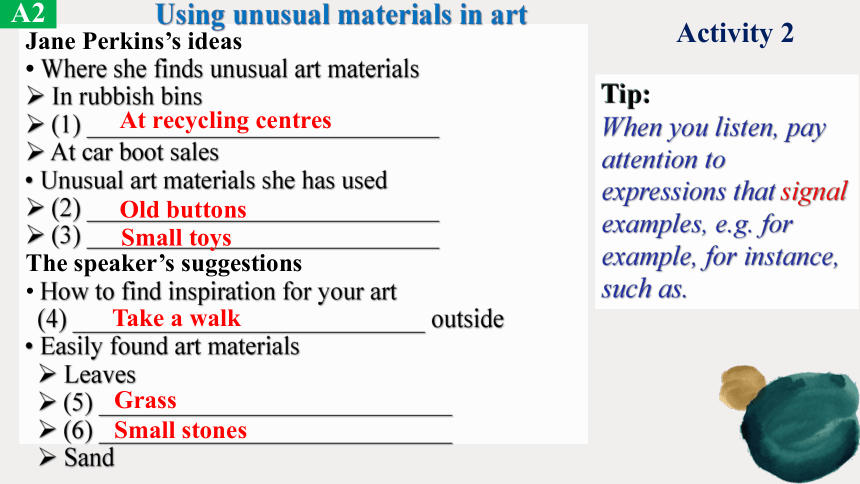
文档简介
(共22张PPT)
Unit 3 The art of painting
Integrated skills
Giving instructions for making an unusual picture
Brain-storming
What other unusual materials in art can you think of
slices of bread
Pizza
strings
Main Task
Giving instructions for making an unusual picture
When we think about great art, we often think of paintings hanging in museums. But great art doesn’t necessarily require paints and a paintbrush. There are all kinds of materials that can be used to create amazing works of art. With a little imagination, almost any object can be turned into a work of art. In fact, many of today’s most creative artists use everyday objects to make their artworks. Jane Perkins is one such artist: she uses a wide range of found materials to make her art. She is wel known for her portraits of famous people. She creates these using whatever she finds in rubbish bins, at recycling centres or at car boot sales. For example, she has used old buttons and even small toys to make her portraits. What one person regards as rubbish, an artist may regard as a source of creativity. But you don’t necessarily have to fish(寻找) around for used objects to find inspiration for your art. Instead, you could take a walk outside and look for interesting natural materials. Nature is a great source of unexpected art supplies such as leaves, grass, smal stones and sand. All it takes is a little bit of imagination .
Watching
A1:Now Lisa has found a TV programme about the use of unusual materials in art. Watch and finish the exercises below.
Activity 1
Watching
A1:Now Lisa has found a TV programme about the use of unusual materials in art. Watch and finish the exercises below.
Page 36
1. What do many creative artists use to make their artworks
Everyday objects.
2. What is Jane Perkins well known for
Portraits of famous people.
3. What may an artist think of the things that we regard as rubbish
A source of creativity.
4. What plays an important role in finding inspiration for your art from nature
Imagination.
Activity 1
When we think about great art, we often think of paintings hanging in museums. But great art doesn’t necessarily require paints and a paintbrush. There are all kinds of materials that can be used to create amazing works of art. With a little imagination, almost any object can be turned into a work of art. In fact, many of today’s most creative artists use everyday objects to make their artworks. Jane Perkins is one such artist: she uses a wide range of found materials to make her art. She is wel known for her portraits of famous people. She creates these using whatever she finds in rubbish bins, at recycling centres or at car boot sales. For example, she has used old buttons and even small toys to make her portraits. What one person regards as rubbish, an artist may regard as a source of creativity. But you don’t necessarily have to fish around for used objects to find inspiration for your art. Instead, you could take a walk outside and look for interesting natural materials. Nature is a great source of unexpected art supplies such as leaves, grass, smal stones and sand. All it takes is a little bit of imagination .
Task Cycle One: Watching
Activity 1
Jane Perkins’s ideas
Where she finds unusual art materials
In rubbish bins
(1) ____________________________
At car boot sales
Unusual art materials she has used
(2) ____________________________
(3) ____________________________
The speaker’s suggestions
How to find inspiration for your art
(4) ____________________________ outside
Easily found art materials
Leaves
(5) ____________________________
(6) ____________________________
Sand
Using unusual materials in art
At recycling centres
Old buttons
Small toys
Take a walk
Grass
Small stones
Tip:
When you listen, pay attention to expressions that signal examples, e.g. for example, for instance, such as.
A2
Activity 2
Writing
D
Write your step-by-step instructions.
Planning your writing
Learning about the text type
What are instructions
Instructions are the written information that tells readers how to do or use something. This type of writing is supposed to include enough details so that readers can follow easily.
Brief introduction
Things you need
Use numbers when listing the steps
Title
Steps you do
Learning about the structure
Ending
Passive voice
Learning about the structure
How to
Have you ever tried to Actually, it is inspiring to do so. Here are some practical ways to .
What you need
What to do
Step 1:
Step 2:
Step 3:
Step 4:
When you finish , display it to your family and share the happiness.
Sentences are short.
Imperative mood
Learning about the language
What are the features of language used in instructions
Your sentences should be short and clear.
Use the imperative mood or passive voice in each step.
Learning about the language
Checking your writing
Remember to check your writing after you finish and exchange drafts between you and your partner.
Pay attention to the following aspects:
★Punctuation ★Spelling
★Grammar ★Choice of words
★Style (formal / informal) ★Structure
Learning about the structure
Learning about the structure
Learning about the structure
How to make a mooncake
Have you ever tried to make a mooncake Actually, it is inspiring to do so. Here are some practical ways to make a mooncake.
What you need
Oil
Flour(面粉)
Syrup(糖浆)
Alkaline water(碱水)
Eggs
What to do
Step 1: Mix together oil, flour and alkaline water for the dough.
Step 2: Prepare the egg yolks(蛋黄).
Step 3: Wrap(包) the fillings(馅料) with the dough.
Step 4: Emboss(压花)the dough and put it to the oven.
When you finish making a mooncake, display it to your family and share the happiness.
When walking in the local park or on campus, we often find colourful fallen leaves. Have you ever thought about collecting them and making them into a piece of artwork Depending on the colours, shapes and sizes of the leaves you find, you can create various pictures. We are going to make a unique picture showing beautiful goldfish swimming in a pond with colourful water plants in it!
Making a unique picture with leaves
Materials and tools:
Leaves of different colours, shapes and sizes
Scissors
Glue
A piece of A4-size paper
Directions:
Step 1: Collect red, yellow and green leaves of various shapes and sizes.
Step 2: Select small red leaves to be the lips of the fish and then cut small circles from some of the other red leaves to make the eyes of the goldfish.
Step 3: Find appropriate leaves, preferably yellow in colour, to make the bodies, fins and tails of the fish. If the leaves are not the right shape, cut them with scissors. Use the rest of the leaves as water plants.
Step 4: Arrange your leaves on a piece of paper to create the image of goldfish swimming among the colourful water plants.
Step 5: Glue the leaves to the paper.
Once everything is dry, show your unique masterpiece to your classmates!
Homework
Polish up your writing and make a presentation to the class.
Unit 3 The art of painting
Integrated skills
Giving instructions for making an unusual picture
Brain-storming
What other unusual materials in art can you think of
slices of bread
Pizza
strings
Main Task
Giving instructions for making an unusual picture
When we think about great art, we often think of paintings hanging in museums. But great art doesn’t necessarily require paints and a paintbrush. There are all kinds of materials that can be used to create amazing works of art. With a little imagination, almost any object can be turned into a work of art. In fact, many of today’s most creative artists use everyday objects to make their artworks. Jane Perkins is one such artist: she uses a wide range of found materials to make her art. She is wel known for her portraits of famous people. She creates these using whatever she finds in rubbish bins, at recycling centres or at car boot sales. For example, she has used old buttons and even small toys to make her portraits. What one person regards as rubbish, an artist may regard as a source of creativity. But you don’t necessarily have to fish(寻找) around for used objects to find inspiration for your art. Instead, you could take a walk outside and look for interesting natural materials. Nature is a great source of unexpected art supplies such as leaves, grass, smal stones and sand. All it takes is a little bit of imagination .
Watching
A1:Now Lisa has found a TV programme about the use of unusual materials in art. Watch and finish the exercises below.
Activity 1
Watching
A1:Now Lisa has found a TV programme about the use of unusual materials in art. Watch and finish the exercises below.
Page 36
1. What do many creative artists use to make their artworks
Everyday objects.
2. What is Jane Perkins well known for
Portraits of famous people.
3. What may an artist think of the things that we regard as rubbish
A source of creativity.
4. What plays an important role in finding inspiration for your art from nature
Imagination.
Activity 1
When we think about great art, we often think of paintings hanging in museums. But great art doesn’t necessarily require paints and a paintbrush. There are all kinds of materials that can be used to create amazing works of art. With a little imagination, almost any object can be turned into a work of art. In fact, many of today’s most creative artists use everyday objects to make their artworks. Jane Perkins is one such artist: she uses a wide range of found materials to make her art. She is wel known for her portraits of famous people. She creates these using whatever she finds in rubbish bins, at recycling centres or at car boot sales. For example, she has used old buttons and even small toys to make her portraits. What one person regards as rubbish, an artist may regard as a source of creativity. But you don’t necessarily have to fish around for used objects to find inspiration for your art. Instead, you could take a walk outside and look for interesting natural materials. Nature is a great source of unexpected art supplies such as leaves, grass, smal stones and sand. All it takes is a little bit of imagination .
Task Cycle One: Watching
Activity 1
Jane Perkins’s ideas
Where she finds unusual art materials
In rubbish bins
(1) ____________________________
At car boot sales
Unusual art materials she has used
(2) ____________________________
(3) ____________________________
The speaker’s suggestions
How to find inspiration for your art
(4) ____________________________ outside
Easily found art materials
Leaves
(5) ____________________________
(6) ____________________________
Sand
Using unusual materials in art
At recycling centres
Old buttons
Small toys
Take a walk
Grass
Small stones
Tip:
When you listen, pay attention to expressions that signal examples, e.g. for example, for instance, such as.
A2
Activity 2
Writing
D
Write your step-by-step instructions.
Planning your writing
Learning about the text type
What are instructions
Instructions are the written information that tells readers how to do or use something. This type of writing is supposed to include enough details so that readers can follow easily.
Brief introduction
Things you need
Use numbers when listing the steps
Title
Steps you do
Learning about the structure
Ending
Passive voice
Learning about the structure
How to
Have you ever tried to Actually, it is inspiring to do so. Here are some practical ways to .
What you need
What to do
Step 1:
Step 2:
Step 3:
Step 4:
When you finish , display it to your family and share the happiness.
Sentences are short.
Imperative mood
Learning about the language
What are the features of language used in instructions
Your sentences should be short and clear.
Use the imperative mood or passive voice in each step.
Learning about the language
Checking your writing
Remember to check your writing after you finish and exchange drafts between you and your partner.
Pay attention to the following aspects:
★Punctuation ★Spelling
★Grammar ★Choice of words
★Style (formal / informal) ★Structure
Learning about the structure
Learning about the structure
Learning about the structure
How to make a mooncake
Have you ever tried to make a mooncake Actually, it is inspiring to do so. Here are some practical ways to make a mooncake.
What you need
Oil
Flour(面粉)
Syrup(糖浆)
Alkaline water(碱水)
Eggs
What to do
Step 1: Mix together oil, flour and alkaline water for the dough.
Step 2: Prepare the egg yolks(蛋黄).
Step 3: Wrap(包) the fillings(馅料) with the dough.
Step 4: Emboss(压花)the dough and put it to the oven.
When you finish making a mooncake, display it to your family and share the happiness.
When walking in the local park or on campus, we often find colourful fallen leaves. Have you ever thought about collecting them and making them into a piece of artwork Depending on the colours, shapes and sizes of the leaves you find, you can create various pictures. We are going to make a unique picture showing beautiful goldfish swimming in a pond with colourful water plants in it!
Making a unique picture with leaves
Materials and tools:
Leaves of different colours, shapes and sizes
Scissors
Glue
A piece of A4-size paper
Directions:
Step 1: Collect red, yellow and green leaves of various shapes and sizes.
Step 2: Select small red leaves to be the lips of the fish and then cut small circles from some of the other red leaves to make the eyes of the goldfish.
Step 3: Find appropriate leaves, preferably yellow in colour, to make the bodies, fins and tails of the fish. If the leaves are not the right shape, cut them with scissors. Use the rest of the leaves as water plants.
Step 4: Arrange your leaves on a piece of paper to create the image of goldfish swimming among the colourful water plants.
Step 5: Glue the leaves to the paper.
Once everything is dry, show your unique masterpiece to your classmates!
Homework
Polish up your writing and make a presentation to the class.
同课章节目录
- Unit 1 Food matters
- Welcome to the unit
- Reading
- Grammar and usage
- Integrated skills
- Extended reading
- Project
- Unit 2 The Universal Language
- Welcome to the unit
- Reading
- Grammar and usage
- Integrated skills
- Extended reading
- Project
- Unit 3 The art of painting
- Welcome to the unit
- Reading
- Grammar and usage
- Integrated skills
- Extended reading
- Project
- Unit 4 Exploring poetry
- Welcome to the unit
- Reading
- Grammar and usage
- Integrated skills
- Extended reading
- Project
